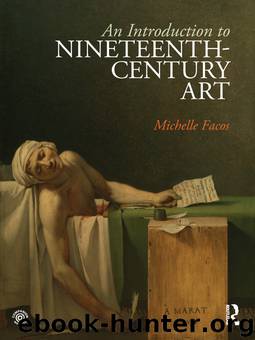An Introduction to Nineteenth-Century Art by Facos Michelle

Author:Facos, Michelle
Language: eng
Format: epub
Publisher: Taylor and Francis
Published: 2011-03-11T05:00:00+00:00
PICTORIALISM AND NEW TECHNOLOGIES
Pictorialism, an international movement seeking to promote photography as a fine art, began in 1889. Members subordinated fact to beauty and encouraged experimentation. Manipulating negatives and the printing process enabled photographers to achieve a wide range of aesthetic effects and to distinguish their artful work from the flood of banal documentary images. According to the Pictorialists, a good photograph evidenced the stamp of its maker’s singular, personal expression. Although Pictorialists were not explicit about how this should be achieved, their photographs —Emerson’s for example—are often recognizable by their beautiful surfaces, subtle tonal relationships, and evocation of mood.
The struggle for photography’s acceptance as fine art became intense in the 1890s under the leadership of Pictorialist photographers who organized and mobilized. The Kamera Klub in Vienna and The Club of Photographic Art Lovers in Lvov, Poland formed in 1891, followed by The Linked Ring (whose membership included Emerson) in London in 1892. The Linked Ring sponsored the first annual exhibition of Pictorialist photography in 1893. The same year, museum director Alfred Lichtwark staged the Hamburg Kunsthalle’s first International Exhibition of Amateur Photography, displaying more than 7,000 photographs in the painting galleries, a bold and controversial decision. The Munich Secession—an independent exhibiting organization established by painters and sculptors to compete with the Academy—was the first to include photographs in its art exhibitions, in 1898. Although this landmark event paved the way for the inclusion of photography in art exhibitions, not until the twentieth century was photography truly accepted as a fine art.
Along with rapid improvements in the chemical and technical processes for producing photographs came improvements in cheap and mass reproduction. A rapid rise in literacy, along with an urban population explosion, generated a demand for books, journals, and newspapers, preferably illustrated ones. Because photographic prints could only be produced a few at a time, a method was needed to reproduce them in ink, a much cheaper and quicker process, and one which could be integrated on the same page as the printed word. Until 1875, when Charles Gillot developed a photomechanical process for producing metal relief plates directly from photographs, wood engravers translated images from drawings, prints, paintings, and photographs onto the end grain of wood blocks that were then inked and printed. Guillot’s process could only reproduce lines and blocks of solid color—it was incapable of producing shadows or nuances of shade. Because it was photomechanical, it was much quicker, more accurate, and less expensive than wood engraving, and could be integrated onto a printed page. In 1880, Stephen Horgan, a photographer for the New York Daily Graphic, developed the half-tone process. This translated photographic images into series of tiny dots, resulting in more nuanced images than Guillot’s process. Because half-tone plates were in relief, they could easily be adapted to letterpress printing presses. In 1886, Ottmar Mergenthaler invented the more rapid and efficient linotype process, the process by which newspapers were printed until the late twentieth century.
Download
This site does not store any files on its server. We only index and link to content provided by other sites. Please contact the content providers to delete copyright contents if any and email us, we'll remove relevant links or contents immediately.
The Secret History by Donna Tartt(18224)
Red Sparrow by Jason Matthews(5203)
Harry Potter 02 & The Chamber Of Secrets (Illustrated) by J.K. Rowling(3559)
In a Sunburned Country by Bill Bryson(3376)
Drawing Cutting Edge Anatomy by Christopher Hart(3301)
Figure Drawing for Artists by Steve Huston(3277)
Harry Potter and the Prisoner of Azkaban (Book 3) by J. K. Rowling(3125)
The Daily Stoic by Holiday Ryan & Hanselman Stephen(3116)
Japanese Design by Patricia J. Graham(3006)
The Roots of Romanticism (Second Edition) by Berlin Isaiah Hardy Henry Gray John(2823)
Make Comics Like the Pros by Greg Pak(2763)
Stacked Decks by The Rotenberg Collection(2699)
Harry Potter and the Deathly Hallows (7) by J.K. Rowling(2554)
Draw-A-Saurus by James Silvani(2514)
Tattoo Art by Doralba Picerno(2497)
On Photography by Susan Sontag(2494)
Foreign Devils on the Silk Road: The Search for the Lost Treasures of Central Asia by Peter Hopkirk(2389)
Churchill by Paul Johnson(2374)
The Daily Stoic by Ryan Holiday & Stephen Hanselman(2353)
